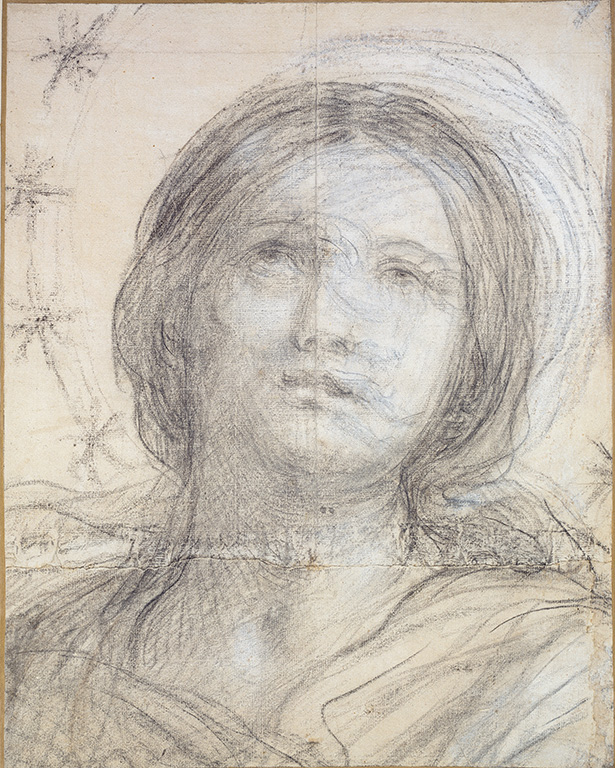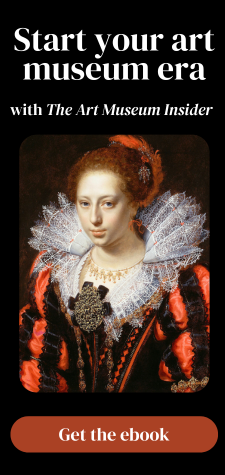Drawings by Elisabetta Sirani and Properzia de’ Rossi
Guest post by Jacqueline Thalmann, Christ Church, Oxford
One of Britain’s most important Old Master drawings collections is held in Christ Church, one of Oxford’s largest colleges. Among the almost 2,000 drawings are four attributed to female artists. The low number is not surprising, as art production and commission were firmly in male hands during the Renaissance and Baroque periods.
However, there were some female masters of equal standing, often daughters trained by their artist fathers, who defied perceived presumptions and challenged their allocated roles. The North-Italian city of Bologna seems to have been particularly open to these defiances and recorded more female artists than any other European city of the time.

Scholars often explain this exception by pointing out that Bologna—home to one of the world’s oldest universities (founded in 1088)—offered a more enlightened climate and open-minded attitude than other Italian towns.
The drawings by women in Christ Church are indeed attributed to Bolognese artists. One is by Properzia de’ Rossi (c. 1490–1530); the other three are by Elisabetta Sirani (1638–1665). Properzia did not have artistic family connections, but was apprenticed to an artist, a highly unusual endeavour.

Elisabetta’s exposure to artistic training was more conventional: her father, Giovanni Andrea Sirani (1610–1670), taught her as well as her two sisters, Barbara and Anna Maria. But it was Elisabetta whose fame would outshine her father’s.
Before discussing two of her drawings, I want to take two short detours. The first stresses the importance of text in establishing the name of an artist. The second highlights the status of drawing in assessing Italian Old Masters.
Printed words—the way to create enduring fame
Artists, it is said, endure through their works. But it is through the words of others that they are truly immortalised, and that their names are remembered and recognised even centuries after their deaths. Their art is described in texts, and their names are preserved in books. Art lovers heard and read about them before they even had the opportunity to travel and see the art with their own eyes. This is important to keep in mind, especially as early art-historical texts defined the canon of Western Art for centuries to come.
Early collectors relied on texts describing the lives and works of the artists o Not to be included meant not to be seen. The written laudations, rather than the works of art themselves, ensured an artist’s durability. Opportunely, Properzia and Elisabetta were included in these texts. Both had notable biographers, which meant that the written word preserved their names—and their fame.
The most prominent of these texts is Giorgio Vasari’s (1511–1574) Lives of the Artists, first published in Florence in 1550. Properzia de’ Rossi is the only female artist mentioned in that first edition. (The second edition of 1568 includes thirteen female artists.)

Elisabetta Sirani was born after Vasari’s death, but she has been immortalised by one of her contemporaries, the art critic Count Carlo Cesare Malvasia (1616–1693), in his account of Bolognese artists entitled Felsina Pittrice (1678). These were well-known books, widely read, often reprinted and partially translated. They were used as reference books by art collectors all over Europe.
We subsequently find the names of Properzia and Elisabetta written on drawings and in inventories, even if this might be wishful thinking on the part of some collectors. But their names had been established, and therefore it was possible to label a body of work with them. In Elisabetta’s case her name was even attached to works that were created by her father. Her name had become better known than his and therefore also more desirable to own a work by Elisabetta than by Giovanni Andrea.
Of the three attributions to Sirani in the Christ Church collection, one is doubtful. But the other two, which I present here, both annotated in the eighteenth century with the name of Elisabetta Sirani, are regarded as genuine works by her hand.
Drawing—a display of true creative intelligence
Old Master drawings hold a particular place in collections. They were in most cases not stand-alone finished works of art, but studies and creative ideas in the process of an artistic development. They were jealously guarded by artists and their workshops, as they held their creators inventive brilliance and secrets. This is what made them desirable to collectors—the perception that a quick scribbled study would offer an insight into the true unfiltered genius of an artist’s mind. The Italian word for drawing—disegno—means not only the purely physical act of drawing, but also the intellectual visualisation of an idea.
While technical painting skills and speed in execution were associated with male artistic competence—the brush being a phallic symbol of artistic prowess—the inventive act of drawing, disegno, was even more regarded as a fundamental manifestation of the male brain. It was seen as a proof of creative intelligence, and as a purely male intellectual ability of which—according to the beliefs of the time—women were biologically incapable.
Yet one of her contemporaries, the Marchese Ferdinando Cospi (1606–1686), expressed that Elisabetta had caught up, even surpassed, her male colleagues. In a 1662 letter to Cardinal Leopoldo de’ Medici (1617–1675), he praised her as “the best brush now in Bologna.” Equally important is the fact that she left the largest body of drawings by a female artist of that period—many of them in Leopoldo’s collection. Today they are scattered in museums around the world.
Between a role model and the self

The two drawings by Elisabetta Sirani in Oxford are both large in scale, created with bold, confident black chalk lines on thick paper. One shows the Head of the Madonna with a Halo of Stars, the imagined idealised features of the quintessential role model for women at the time, the Virgin Mary. The other is a study of the artist’s own face.

There are similarities—Elisabetta cannot fully avoid modelling the Madonna after her own features, and in turn aspires in her self-portrait to the image of the saint. But there are significant differences between how she depicts herself and how she portrays a saintly, religious figure, who was also the protectress of Bologna.
The most notable difference is the direct, confident look with which she makes eye contact with the viewer in her self-portrait. We see the same steady eyes with which she studied herself in the mirror during the process of drawing. In detailed observation Elisabetta conveyed the different material properties of what she saw when creating this image of herself—the lightness of her hair that comes out in wisps, the rigidness of the hair band, the cool smoothness of the pearl necklace on her sumptuous neck, and the thin cloth of her blouse against the skin. The contrasting materials surrounding her facial features create a sensuality in the drawing, which, combined with the directness of her unhurried gaze, stands in stark contrast to the detached drawing of the Madonna.
The real woman of the self-portrait that looked you in the eye has been replaced by a female figure who evades direct eye contact. The Madonna has her gaze averted, looking up in admiration with her chin slightly lifted. The viewer can look at her without being in turn provocatively stared back at. The smooth roundness of the facial form remains, but the saint’s mouth is smaller, with a less characteristic upper lip. The nose shorter and more symmetrical. There is little textural differentiation between hair, skin, and cloak. Even in the surrounding halo, the stars are just thick short black chalk lines. One can see that Elisabetta made some alterations with white chalk trying to obliterate an earlier design and developing the image of Mary on paper to represent the acceptable female role model she was—a paragon of flawless womanhood. But for herself, she dared to be something else.

Jacqueline Thalmann is Curator at Christ Church Picture Gallery in Oxford, where she is in charge of the collection of Old Master paintings, drawings and prints. Her interests are broad and far-reaching and are trying to connect what apparently seems disparate. Follow her on Twitter.
More Art Herstory guest posts about Bolognese women artists:
Elisabetta Sirani’s Studio Visits as Self-Preservation: Protecting an Artistic Career, by Victor Sande-Aneiros
Stitching for Virtue: Lavinia Fontana, Elisabetta Sirani, and Textiles in Early Modern Bologna, by Dr. Patricia Rocco
The Restoration of Royalty: Lavinia Fontana’s Queen of Sheba and King Solomon, by Dr. Aoife Brady
Elisabetta Sirani: Self-Portraits, by Jacqueline Thalmann
Celebrating Bologna’s Women Artists, by Dr. Babette Bohn
Lavinia Fontana and Elisabetta Sirani at the Smith College Art Museum, by Dr. Danielle Carrabino
Elisabetta Sirani of Bologna (1638–1665), by Dr. Adelina Modesti
Lavinia Fontana: Italy’s First Female Professional Artist, by Dr. Elizabeth Lev
Sister Caterina Vigri (St. Catherine of Bologna) and “Drawing for Devotion,” by Dr. Kathleen G. Arthur
More Art Herstory guest posts about Italian women artists:
Thoughts on By Her Hand, the Hartford Iteration, by Erika Gaffney
By Her Hand: Personal Thoughts and Reflections on an Exhibition, by Oliver Tostmann
Sister Eufrasia Burlamacchi (Lucca, 1478–1548), by Dr. Loretta Vandi
Artemisia Gentileschi: What Wasn’t in the London Exhibition and Why it Matters, by Dr. Jesse Locker
“La grandezza del universo” nell’arte di Giovanna Garzoni / “The grandeur of the universe” in the art of Giovanna Garzoni (Guest post/review by Dr. Sara Matthews-Grieco)
Plautilla Bricci (1616–1705): A Talented Woman Architect in Baroque Rome, by Dr. Consuelo Lollobrigida
Renaissance Women Painting Themselves, by Dr. Katherine McIver
Orsola Maddalena Caccia (1596–1676), Convent Artist, by Dr. Angela Ghirardi
Two of a Kind: Giovanna Garzoni and Artemisia Gentileschi, by Dr. Mary D. Garrard
The Priceless Legacy of Artemisia Gentileschi: A Curator’s Perspective, by Dr. Judith W. Mann




Hi, I’m researching a potential TV series about lost women artists of the renaissance and de Rossi poses a big mystery – where’s the rest of her work? Could it have been misattributed to other, male artists? Do you know if it is possible to identify a scultpor’s ‘signature’ in the way marble is worked? Any pointers to other research gratefully received, thanks Nic Young